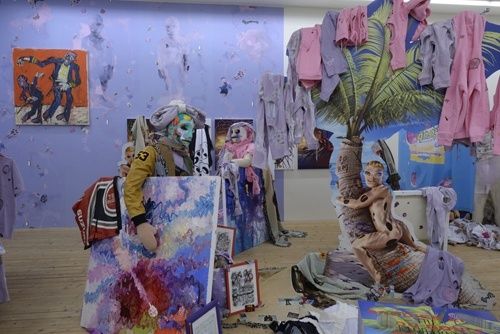Østerrikske forfattere og kunstnere har i årtier rast mot denne østerrikske fascismen, der Austrofaschismus, og landets manglende bearbeidelse av nazifortiden. Nobelprisvinneren Elfriede Jelineks forfatterskap graver i det berget av lik som denne nazibelastede nasjonen består av. Thomas Bernhard, Ingeborg Bachmann, Maja Haderlap, avantgardistene i Wiener Gruppe pluss Die Wiener Aktionisten, samt filmregissørene Michael Haneke, Ulrich Seidl og mange flere, fortsatte og fortsetter ufortrødent å trykke på nasjonens brune smertepunkter.
Aksjonistene så allerede på 1960-tallet, lenge før Høyrepopulisten Jörg Haider dukket opp, sin kunst som et opprør mot staten som de mente forsøkte å dekke erindringen om nasjonens samarbeid med nazistene under en fasade av nasjonal harmløshet og katolsk dobbeltmoral. Aksjonistene ville sprenge stivnede kunstformer og riste nasjonens nevrotiske spissborgere ut av taushet ved hjelp av det de kalte Direkte Kunst. Alle i kretsen hadde tilknytning til billedkunsten, men hadde bokstavelig talt brutt gjennom lerretet og ut av rammen, og brukte i stedet kroppen som performativt materiale og medium, sammen med mat, leire, innvoller og andre kunstfremmede elementer. Seksuelle tabubrudd fra et maskulint ståsted var et sentralt motiv for alle aksjonistene. Det gikk ikke upåaktet hen. Flere av dem, som Otto Muehl, var i løpet av 1960-tallet idømt fengselsstraffer for overtredelse av sedelighetsloven, og de hadde vakt moralsk oppstandelse i offentligheten. Ett eksempel var aksjonen Kunst und Revolution, som fant sted på Universitetet i Wien den 7. juni 1968, og siden har blitt hetende Uni-Ferkelei (universitetsgriseri). Aksjonistene Muehl, Bruce og forfatteren Oswald Wiener hadde lest et manifest for studentene i universitetets store aula. De avsluttet aksjonen med å bæsje på kateteret under avspilling av nasjonalsangen. For denne aksjonen satt Muehl to måneder i fengsel, mens kollega Brus klarte å flykte til Berlin for å unngå å bli arrestert.
Jeg kjente aksjonskunstneren Otto Muehl godt ettersom jeg i ni år fra 1976 til 1985 bodde i kunstnerkollektivet AAO (Aktionsanalytischer Verein) utenfor Wien, som han startet i 1970. Sammen med hundrevis av søkende unge mennesker på venstresiden, samt hippier, drop-outs og terapitrengende, skapte han en utopisk samlivsmodell og kollektivbevegelse som ble Europas lengst eksisterende kollektiv fra denne perioden. Hva som hendte med denne antiautoritære gruppens opprør, og det gikk jo ikke så bra, har jeg skrevet om i boken Kanskje det ennå finnes en åpen plass i verden (2015). Kort oppsummert: Etter mange år der AAO var et av de mest radikale samlivseksperimentene der kunst, terapi, felles eiendom og åpne seksuelle relasjoner inngikk som en særegen 70-tallsmix, regrederte denne selvoppnevnte avantgarden til totalitære ideologier. I 1991 fikk Muehl en dom for seksuelt misbruk av ungdommer og stoffmisbruk.
Stor ble min overraskelse da jeg i fjor høst fikk vite at den første utstillingen i Norden med denne skandaliserte østerrikske aksjonskunstneren åpnet den 25. september i galleri Rod Bianco i Oslo. Bjarne Melgaard, en annen «overskridende kunstner», var kurator for utstillingen med Muehls verk fra 1980-tallet, laget i AAO-kollektivets mest dystopiske fase. Ikke før hadde jeg avsluttet boken om AAO, trodd at jeg har gjort meg ferdig med Muehl som kunstner, leder, forfører, samt seksuell overgriper, så var det som om han sto opp fra boksidene for å minne meg om at jeg ikke blir kvitt ham så lett, ei heller mitt medansvar for det som hendte i det samme kollektivet. Nå som hans kunst ble vist i Oslo, spør jeg meg om det normbrytende i kunsten, og de etiske og moralske spørsmålene når overskridelsene berører levende mennesker, også har et potensial eller en kvalitet?
Nettopp disse spørsmålene ble debattert våren 2015 i forbindelse med Munchmuseets utstilling Melgaard + Munch. Melgaard er bl.a. blitt kritisert for innmontering av reklamebilder av gutter i egne verk, elementer hentet fra pedofili-organisasjonen Nambla. Melgaards video All Gym Queens Deserve to Die ble igjen politianmeldt. I denne videoen blir en naken jentebaby holdt av to voksne der den ene sutter på armen hennes. Lena Lindgren spurte i en leder i Morgenbladet om det «snarere er slik at Melgaards tilhengere lar det etiske fare – man synes det er mindre interessant fordi den estetiske kraften holder. Hva betyr det pedofile materialet i Melgaards utstilling, kunstnerisk og etisk?» Hun fortsetter med å spørre om «sterke» kunstnere lettere går fri moralsk sett – og svarer bekreftende.
Hvordan spilte nettopp denne problemstillingen seg for eksempel også ut i forbindelse med resepsjonen av Karl Ove Knausgårds bokserie Min kamp? Var det ikke slik at før dette verket ble kanonisert, fikk gjennomslag og kvalitetsstempel, mens det ennå var tvil og åpen samtale om den kunstneriske kvaliteten, ble mulige etisk betenkelige sider ved romanseriens bruk av levende modeller heftig diskutert? Knausgårds onkel protesterte mot de angivelig usanne beskrivelsene av sin mor, Knausgårds farmor, seg selv og resten av familien i seriens første bok. Han truet med rettsak. I andre av de seks bindene beskrev Knausgård sin svigermor som skapalkoholiker, han gjorde intime karakterbeskrivelser av egne barn og skrev utførlig om sin kones psykiske problemer, mangel på realitetsmestring og gjentatte sammenbrudd. Så ble det enighet om at dette var en romanserie av høy kunstnerisk kvalitet, at det utvilsomt var diktning som ikke måtte forveksles med den trivielle virkeligheten, og så stilnet alle spørsmål om etikk og overskridelser mellom kunst og liv. Knausgård gikk fri moralsk sett.




